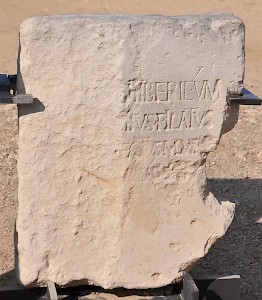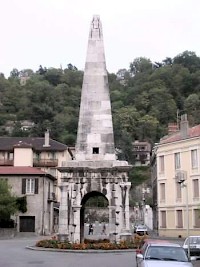Pontius Pilate (8)
Pontius Pilate: Roman prefect of Judaea from 26 CE to 36 CE, best known for the execution of Jesus of Nazareth.
Other evidence
We have discussed Pilate as he is mentioned in the gospels, by Philo and by Flavius Josephus. These are the most important sources. There are, however, some other references to Pilate.

The first of these is the inscription on a block of limestone, which was found at Caesarea in 1961. One half of the stone is badly damaged, but we can still read the other half of it:
. . . . . . S TIBERIEVM
. . [PO]NTIVS PILATVS
[PRAE]CTVS IVDA[EA]E
[REF]ECI[T]
Which means that Pontius Pilate, prefect of Judaea, had restored something called a "...s Tiberieum". Among scholars, this caused some sensation, because it proves that Pilate's title was praefectus Judaea, and not procurator Judaea, as the Roman historian Tacitus states.note The first readable word, Tiberieum, remains a mystery. Probably, it refers to a temple dedicated to the emperor Tiberius.
Our next item consistes of early Christian literature. The authors did their best to exculpate Pilate from the death of Jesus. In his Apologeticum, Tertullian thinks that Pilate had veen been a Christian at heart. The author of the text known as the Didascalia apostolorum informs us that Pilate did in fact not consent with the wicked deeds of the Jews.note Augustine, the influential bishop of Hippo (354-430), classified Pilate among the prophets in one of his sermons.note These authors also made up some details that are missing in our primary sources such as the name of Pilate's wife, Procla. Their agenda is obvious: they wanted to show that Christians did not worship a crucified criminal and were no menace to Roman society.
We will never know what happened to Pilate after his dismissal. There is an old tradition, however, that Pilate committed suicide on his return. If true, it may have been because he had fallen into disfavor, although there is no reason why he should have. The Christian author Eusebius, who tells the story, thinks that the former governor felt remorse for the execution of Jesus.note

The Ethiopian church, however, believes that Pilate became a Christian and was martyred. These Christians have canonized the governor of Judaea, whose saint's day is June 25. The tradition of Pilate's martyrdom was known in the West, where people thought that he died at Vienna in France, where his tomb was incorrectly identified. Maybe, this legend is an echo from the banishment of another ruler of Judaea, Herod Archelaus.
Finally, there is a mysterious text known as the Acts of Pilate, a kind of report about the death of Jesus, in which the governor of Judaea shows genuine sympathy to those weeping Jews who desire Jesus not to be crucified. Of course, Pilate must have reported about the incident. All governors wrote letters to the emperor, and a Pilate would have boasted the crucifixion of a pretender. Unfortunately, the Acts of Pilate we possess, are not the original report but a fifth century fabrication.
However, the original was accessible in the second century. It is quoted twice in the First Apology of Justin the Martyr, who had to explain Christianity in front of the emperor. He says:
And after Jesus was crucified they cast lots upon his vesture, and they that crucified him parted it among them. And that these things did happen, you can ascertain from the Acts of Pontius Pilate.There are these words: "At his coming the lame shall leap as an hart, and the tongue of the stammerer shall be clear speaking: the blind shall see, and the lepers shall be cleansed; and the dead shall rise, and walk about." And that he did those things, you can learn from the Acts of Pontius Pilate.
It is very unlikely that Justin, whose life was at stake, would have invented a fake report. Besides, the statements attributed to Pilate are not incredible: Pilate would have been a strange pagan if he did not believe reports about miracle workers, and would have been a strange governor if he did not mention these stories in his letter to the emperor. Moreover, the first statement is at odds with the gospels, which state that Jesus' garments were divided before the crucifixion; a Christian would not write a thing like this. Perhaps we may speculate that Pilate did indeed write something that Christians felt to be proof of their belief, and that the pagans felt they had to destroy, forcing a devout Christian to write a replacement.
Literature
- G. Alföldy, "Pontius Pilatus und das Tiberieum von Caesarea Maritima" in: Scripta classica Israelitica 18 (1999) 85-108
- H.K. Bond, "The coins of Pontius Pilate: part of an attempt to provoke the people or to integrate them into the Empire?", in: Journal for the study of Judaism in the Persian, Hellenistic and Roman periods (1996).
- Raymond E. Brown, The death of the Messiah. From Gethsemane to the Grave. A commentary on the passion narratives in the four gospels. Volume I (1994, New York), pages 693-710.
- J.P. Lémonon, Pilate et le gouvernement de la Judée: textes et monuments, (1981 Paris)
- B. McGing, "Pontius Pilate and the Sources" in Catholic Biblical Quarterly 53 (1991), pages 416-38